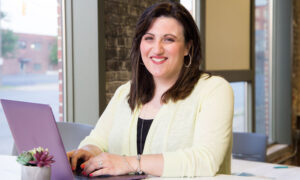By Steve Yablonski
After a substantial drop in fundraising, United Way has a new goal: to raise $500,00 this year
Each year, the United Way of Greater Oswego County collects donations from corporations, businesses and individuals. It puts those funds to use by financially augmenting several organizations around Oswego County.
They’ve faced some tough challenges the past few years.
Issues such as the overall local economy, company closing or downsizing, changes in corporate philanthropy practices and more have made things difficult.
The last two years, COVID-19 brought just about everything to a screeching halt. Fundraising events everywhere were canceled. Nonprofits sought to sustain themselves through virtual events and other creative means.
“We are hoping to rebound from COVID. That’s the biggest thing that has impacted us the last two years,” said Kate Davis Pitsley, United Way’s resource development director. “For us it presented the issue of not being able to do our workplace campaigns in the traditional way — going into Novelis and into Exelon and all those large manufacturing companies and having face-to-face contact with the employees.”
The fundraisers many companies held to benefit the United Way were impacted as well, but not exactly in the same way, Pitsley noted. Some things were held outdoors, like golf tournaments. However, some people didn’t come and golf because they were concerned over COVID-19 restrictions.
The United Way has implemented staggered start times.
There used to be a big sit-down dinner at the end of the day. Participants had had a good round of golf and were feeling good about the United Way; so that when asked to donate more for the 50/50 raffle or some of the silent auction things, they are more than willing to do so. But the pandemic brought funding down. Instead of the dinner, the United Way switched to boxed dinners and everyone took it to go.
But the sponsors have really stepped up to help, Pitsley pointed out.
This year, they were back to normal (July 11 at the Oswego Country Club). They did a morning and an afternoon flight.
With so many golfers, they held a shotgun start at 8 o’clock and then another one at 2 o’clock.
“That fit people’s schedules. We had a big group that goes at 8 and then we have a smaller group that goes at 2. There are people who really need to be in their office on a weekday morning. So this accommodated them,” she noted. “They got in there and got their stuff all done and then came out to golf in the afternoon.”
“Our campaign cabinet typically sets our goal every year. This year it is $500,000,” she said. “Last year and the year before that were anomalies. So our fundraising went down. We know that we have the capabilities and the resources now to get to the goal. We have done it before in a normal quote unquote year. We’re trying to get back to normal and make up some of what we have lost over the past couple of years.”
“We haven’t lost any companies (due to closure, relocation etc) in the last couple of years. It has been relatively steady; even with some of the ownership changes that have taken place at some companies, they still, the employees, have a strong commitment to the United Way. They continue to make strong donations,” Pitsley noted.
It impacts the campaign when any of the large businesses close. “The loss of places like Nestles and Miller years ago—that was a huge drop. Thankfully we haven’t experienced that in a long time,” she added. “The nice thing is there are always new companies that are willing to step up. Sometimes you lose one – but then you gain one.”
For instance, she said, “We have developed a very good relationship with Burritt Motors over the past couple of years. They do our Day of Caring event and they always sponsor our golf event. Just this year, they decided to become a workplace campaign location.”
Why are the small donations from individuals important?
“That $10 or $20 might be something that is intrinsic to a program or a campaign. Yes, a $1,000 donation goes a long way; but even a $10 donation, they really add up person to person to person,” Pitsley explained.
The United Way’s allocation committee is getting started, she said.
The allocations is a process where United Way of Oswego County determines how to allocate the funds that are collected during the annual employer campaigns and local fundraising efforts, explained Patrick Dewine, executive director UWGOC.
“The funding cycle is over a two-year period. As a reputable steward of donor dollars, we wanted to ensure that our member agencies and their various programs can count on a certain level of funding over a longer period, so that they could better plan their budgets,” he said. “During the allocation process volunteers in our community are recruited and assigned to one of our four panels.”
Children and Family Services
Health and Special Needs
Emergency Services
Youth Development
It’s an accountability process; agencies explain how they used the last year’s money, how they plan to use this year’s money, how many people they’re serving and the results—the impact those dollars have in the community.
As part of the vetting process, the volunteers are provided copies of the funding request applications and program budgets to review and then visit many of these agencies and hear presentation on the various programs.
“At the end, the volunteers are able to ask questions and many times complete tours and see the programs in action. Once the volunteers have completed all their assigned visits, they reconvene one final time as a panel to discuss each program and vote on funding for the programs. Each panel is allocated a dollar amount to be spread over the various programs in their panel. Once each panel decides on the funding amounts, they will submit their recommendations to the board for review and a vote,” Dewine said.
“The volunteers go into the workplace to see what the agency actually does. It has a stronger impact on the committee. They go to different agencies, get a tour and see someone, an individual who has been impacted by the program and they talk with the committee members,” Pitsley explained. “So it is nice to go to the locations where the services are, the programs are and interact with the people who benefit from the programs. It’s easier for committee members to understand what is going on by going into the building where the services are taking place and meeting an individual. It is better than having someone from the agency come to the United Way and give a presentation. We really get immersed in it when we go and visit them.”
The allocations process is overseen by United Way’s Allocation Committee, which is comprised of local community leaders and stakeholders. Members include (chair) Shawn Seale of Key Bank, Wally Dengos from National Grid, John Ferry from DSS and Mark Mirabito from SUNY Oswego.
“We are very excited to be able to start this allocations process again, as COVID has caused a delay in being able to get out and visit the agencies and programs,” Dewine said. “The board continued to meet uninterrupted the past two years and funding wasn’t disrupted during COVID. But, we certainly felt it was imperative to get our community involved in the process again.”
There are 29 programs right now and there are fewer agencies (because some have consolidated).
Funds raised by UWGOC stay local (99%), according to Pitsley.
“Really almost everything raised from our campaign stays local,” she said. “There are some funds that are used elsewhere—if it’s ‘donor selected.’ And, some of the funded programs do reach beyond the county’s borders. We pay very nominal dues to United Way Worldwide just to be a part, to be a chapter under their umbrella.”



